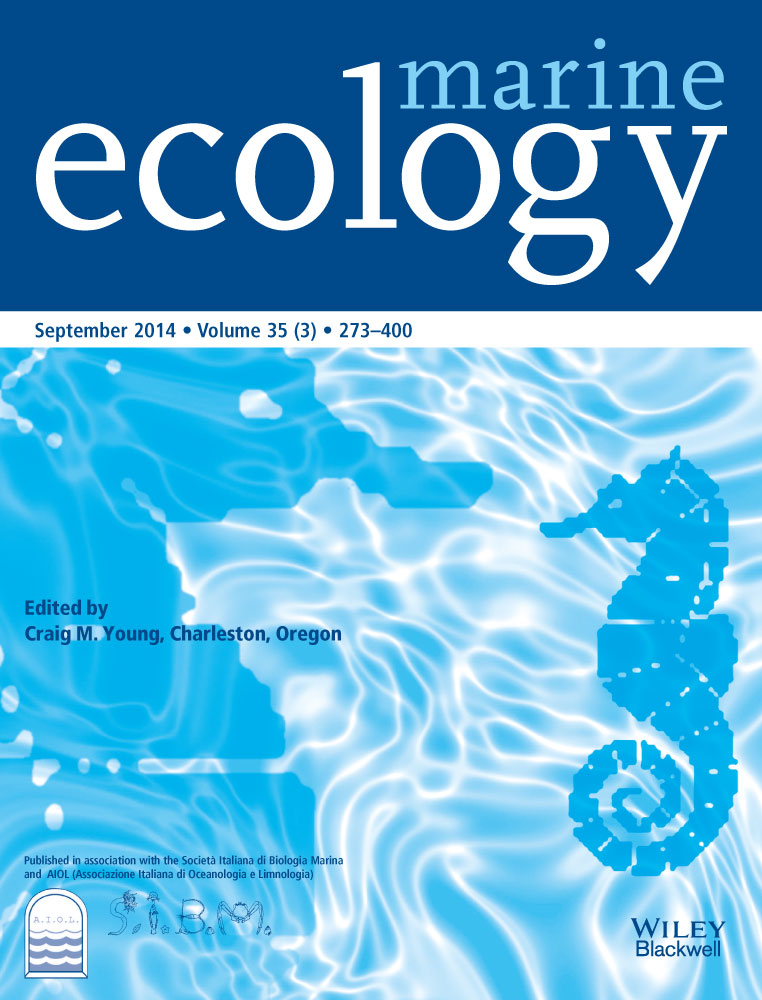Influence of tidal regime, diurnal phase, habitat and season on feeding of an intertidal crab
Abstract
The relationship between diet and feeding activity of intertidal crabs, and environmental cycles (tidal, daily and seasonal), habitat and level of the intertidal zone (high/low) was studied using Neohelice granulata (Brachyura, Varunidae) as a model. This is a semi-terrestrial burrowing crab occupying different habitats in the Southwestern Atlantic coasts and estuaries from bare low intertidal mudflats to high intertidal salt marshes, and from fine, organic matter rich sediment to very coarse sediment with low content of organic matter. The study was carried out in two contrasting habitats of three sites with diverse sets of physical and biological conditions. Diet and feeding of adult N. granulata were indirectly studied through the proportion of food items and the presence/absence of food in crab stomachs, respectively. This species has a dual mode of feeding: predominantly herbivorous (live plants or plant litter in salt marshes) or deposit feeder (superficial sediment and detritus in mudflats), but the quantity and quality of ingested food varies among habitats and sites. A trend to omnivory (including algae and conspecifics) was detected in relation to low quality of resources. Feeding activity modulated by a complex interaction of factors varied according to spatial and/or temporal changes in some natural cycles. Males and non-ovigerous females fed preferably after dark and during submersion periods, but also after emersion periods if mudflat sediment remained wet; salt marsh crab feeding is somewhat independent of light and tidal cycles. Ovigerous females almost never fed. Both diet and feeding activity of this crab seem to be flexible traits adapted to different combinations of physical and biological factors.
Introduction
The feeding activity of an organism is related to the structures and abilities that allow them to obtain, manipulate and ingest food, but also to the use of habitat, its ecology and its physiology. Feeding habits of intertidal invertebrates show tidal, daily or seasonal changes (mainly in temperate areas) as a consequence of a complex combination of rhythmically varying factors. In intertidal crabs, feeding has been less studied than other rhythmic activities as locomotion or reproduction. However, some evidence suggests that it may not agree with other, more conspicuous, activity pulses (e.g. Aguzzi et al. 2004). In addition, estuarine intertidal crabs feeding in different parts of an estuary could face not only distinct tidal patterns but also different predation pressures and food resources. Therefore, variations in feeding activity and diet are expected (Ryer 1987; Heguele-Drywa & Normant 2009). Feeding of intertidal crabs, active at low tide, or moving in shallow clear coastal waters, can be directly seen in natural conditions (Wolfrath 1992; Cannicci et al. 1999). In contrast, feeding in highly turbid water of estuaries is more difficult to observe and must instead be evaluated by a time/tide scheduled catch and the subsequent examination of the amount and type of material in the stomach (Ryer 1987; McTigue & Feller 1989; Cannicci et al. 1996; Mascaró et al. 2007).
Neohelice granulata (=Chasmagnathus granulatus) is a semiterrestrial burrowing crab inhabiting middle and high intertidal salt marshes of the halophytic grass Spartina sp. along the Southwestern Atlantic coast, between Río de Janeiro (Brazil) and Golfo Nuevo (Argentina). This crab is the key species in South American coastal ecosystems and is also considered an emergent animal model for biochemical, physiological and ecological research (Spivak 2010). Neohelice granulata is an excellent species to study the relationship among diet and feeding activity of intertidal crabs with tidal, daily and seasonal cycles, habitat, and level of the intertidal zone (high/low) due to its wide geographical distribution, the presence of estuarine and marine populations that face different environmental conditions (including tides, temperature, sediment and food resources), and the ability to colonize contrasting habitats in each site (salt marshes and mudflats).
Sediment and Spartina remains represented more than 70% of the ingested food of N. granulata in a Brazilian population, with annelids and conspecifics following them in relative importance (c. 20%; D'Incao et al. 1990). Furthermore, differences in diet have been detected between microhabitats in a coastal lagoon from Argentina: crabs fed on leaves of Spartina densiflora and on sediments when their burrows were among the roots of this grass or in bare mudflats, respectively (Iribarne et al. 1997). However, the only feeding activity reported in natural conditions was herbivory: individuals were observed climbing S. densiflora stems under water when rising tides occasionally covered salt marshes (Alberti et al. 2007a). Neohelice granulata move mainly during high tides (Luppi et al. 2013), although they are also active at low tide inside and around their burrows, and can tolerate long periods of emersion (Santos et al. 1987; Fathala et al. 2010). This species was active in an extremely broad range of temperatures, between 10 and 38 °C in air and between 0.5 and 32 °C underwater. Movement patterns did not vary during the year, with the exception of seasonal reproductive activities (Luppi et al. 2013).
There is no current information on the time and conditions (e.g. tidal phase) in which N. granulata feed, or on the temporal changes in its feeding activity or diet. In addition, differences in feeding habits at a large spatial scale, including not only estuarine but also marine habitats, are unknown. The aim of this research was to study diet composition and feeding activity of this crab, in mudflat and salt marshes, comparing daylight/darkness and emersion/submersion conditions during the year in three geographically distant sites exposed to different tidal amplitude, different Spartina species, and dissimilar organic matter content of the sediment. We hypothesized that feeding activity and consumed items could be plastic traits which change following different combinations of physical factors and food availability during the year at each site.
Material and Methods
Study areas
Three sites that form a gradient of increasing tidal amplitude southward, also associated to changes in salt marsh communities (Isacch et al. 2006), were selected: Mar Chiquita (MC), Bahía Blanca (BB) and San Antonio Bay (SA) (Fig. 1). A more detailed description of sites is available in Luppi et al. (2013).
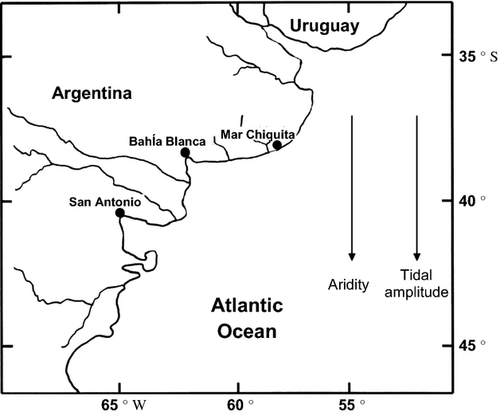
Mar Chiquita (37º45′ S, 57º19′ W) is the northernmost site. This coastal lagoon with a semidiurnal microtidal regime (0.3–1 m amplitude, Servicio de Hidrografía Naval -SHN-, Argentina), is connected with the open sea through a narrow channel. Tidal influence depends on the wind direction and intensity, tidal phase and freshwater runoff. The upper intertidal is a mixed Spartina densiflora and Sarcocornia perennis salt marsh (Isacch et al. 2006), and the middle and lower intertidal are mudflats. Sediments are fine, with high organic matter content (average 4%) and high penetrability (Spivak et al. 1994). Crabs occupy upper and middle intertidal zones (Fig. 2a).
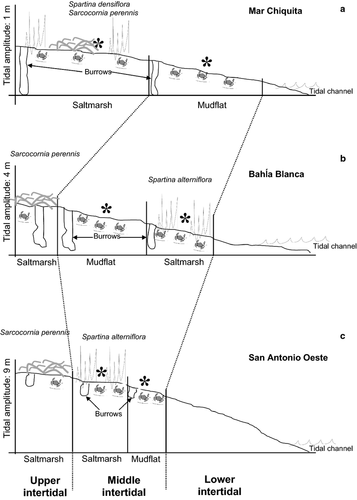
The intermediate site, BB (38º45′ S, 62º15′ W), is a large estuary with 1550 km2 of low-energy tidal flats. The tidal regime is semidiurnal and mesotidal (maximal amplitude 3.6 m, SHN). Sediments are fine with high organic matter content (average 3.6%) and high penetrability (M. Albano, unpublished observations). The intertidal is characterized by an upper zone formed by a S. perennis salt marsh (Isacch et al. 2006), a middle zone divided into two parts, an upper mudflat and a lower narrow belt of Spartina alterniflora, and a lower zone that is a bare mudflat. Crabs are present in the upper and middle intertidal (Fig. 2b).
San Antonio (40°46′ S, 64°50′ W), the southernmost site, is a bay opening into San Matías Gulf. It has a semidiurnal macrotidal regime (up to 9 m amplitude, SHN) with extensive sand-cobble intertidal flats. The upper intertidal is a S. perennis salt marsh; the middle intertidal is divided into a S. alterniflora salt marsh upwards (Isacch et al. 2006), and a mudflat which is continuous with the lower intertidal. Organic matter content (average 1.35%) and penetrability of sediment are very low (C. Bas et al. 2005). Crabs occupy the upper and middle intertidal (Fig. 2c).
Crab collection
Mature crabs (≥20 mm CW) from both habitats (Spartina sp. salt marsh and mudflat) of each site were sampled seasonally during 48 h. Samples were obtained approximately every 6 h, in the midpoint between a flood tide and the following ebb tide when burrows were visible. Food in stomachs was considered ingested at any time during the 6-h period previous to sample collection (average value of gut passage time of Neohelice granulata estimated in the laboratory was 7.5 h; Lancia, 2013). Accordingly, crabs sampled in the midpoint of the high tide had fed while uncovered by water and those sampled in the midpoint of the ebb tide had fed while covered by water. Each sample consisted of seven males, seven non-ovigerous females and seven ovigerous females (in spring and summer, when present) randomly collected from burrows by hand. Crabs were immediately killed, stomachs were extracted with fine point forceps and separately fixed with 4% formalin and stored in labeled tubes. The following data were recorded for each sample: date, hour, habitat (mudflat or salt marsh), tidal phase previous to sampling (flood or ebb tide), water covering (emersed or submersed independently of tidal phase, as in many cases high tides did not cover sampled areas), diurnal phase, (daylight or darkness, depending on conditions prevailing along the 6-h period previous to sampling).
Diet composition
Stomachs were opened in the laboratory with fine scissors, content was emptied on a small Petri dish (30 mm diameter), and uniformly distributed forming a thin layer. To evaluate the type of ingested food, content was determined under a stereomicroscope and items occupying more than 20% of volume (by direct estimation of the total surface covered by the item) were assigned a value between 1 and 5 (1 = 20% of volume, 5 = 100% of volume). A percent volume frequency distribution was constructed for each item. Those representing <20% of the total content were only recorded as ‘present’. Considering that halophytic vegetal matter and sediment represented the bulk of food in stomachs of all sites and habitats (except in spring and summer in SA, when stomachs had measurable volumes of algae), variation in the proportion of sediment was used to evaluate differences in diet composition among sexes, habitats, seasons and sites. A log-linear test (Norman & Streiner 1996) was performed comparing the percent volume frequency distributions. The presence of other items consistently appearing in measurable quantities was evaluated with a Chi-squared test by analyzing differences between sexes, habitats and sites.
Feeding activity
The presence/absence of food in stomachs of males, and ovigerous and non-ovigerous females was used to evaluate the effect of environmental variables on feeding activity for each site by a generalized linear model, performing a factorial ANOVA with a binomial distribution and a logit link function (R Development Core Team 2008). Factors were diurnal phase, water covering, habitat and season.
Gut ecomorphology
In the three sites, the standardized stomach size of crabs representing the complete adult size range was calculated as the ratio between stomach width (SW) and carapace width (CW) (Griffen & Mosblack 2011) to establish the relationship between gut size and percentage of herbivory. Maximum CW of each crab was measured with a caliper (nearest 0.1 mm) and stomachs were measured under a stereomicroscope (nearest 0.01 mm) by taking the maximum width of the cardiac chamber between the extremes of both laterocardiac ossicles (Covelo de Zolessi & Spiritoso 1985). An ANCOVA test was used to analyze the homogeneity of slopes in the relationship between log CW and log SW among sites. Percentage of herbivory was calculated on the basis of the equation %H = 0.0024*(SW/CW) + 0.24 (Griffen & Mosblack 2011).
Results
Diet composition
The main food items present in the stomachs of 2940 crabs studied from the three sites were sediment and remains of the halophytic grass Spartina (Spartina alterniflora in SA and BB and Spartina densiflora in MC). In MC, stomach content was mainly sediment (≥80% of volume) in mudflats and mainly remains of Spartina spp. in salt marshes. Only 10% of individuals had similar proportions of both types of food (40– 60% of each one). Stomach content of a few crabs (5%) was typical food in the other habitat, i.e. sediment in the salt marsh and vice versa. In BB, more individuals ingested similar quantities of both types of food (18%) and that typical of the other habitat (21%). In SA, a third item, red and brown macroalgae, was common in spring, summer and autumn, and represented up to 30% of stomach contents in both mudflat and salt marsh crabs. It was more frequently eaten by males than by females (χ2 = 6.05, P < 0.05; difference not shown in Fig. 3) and by salt marsh more than by mudflat crabs (χ2 = 9.3, P < 0.01) (Fig. 3). In the latter, the percentage of individuals with similar quantities of different items in their stomachs reached 28% and that of individuals with food typical of the other habitat was 21%.
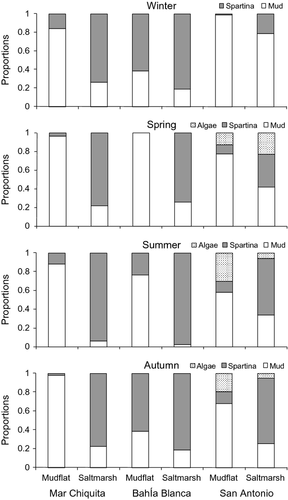
No difference was observed in the proportion of sediment between sexes in the three sites (log-linear test, P > 0.05) and data from both sexes were pooled for subsequent comparisons. The proportion of sediment in stomachs depended on the interaction of habitat, site and season (log-linear test, Table 1). In MC, the average proportion of sediment in stomachs was above 80% in mudflat crabs and below 30% in salt marsh crabs in all seasons (Fig. 3). In BB the proportions were similar to MC in spring and summer, whereas in autumn and winter, more than 60% of the average content in mudflat crabs was remains of S. densiflora (Fig. 3). In SA, the proportion of sediment ingested by mudflat crabs was near 100% in winter but it was lower in the other seasons; at the same time, the proportion of sediment in stomachs from salt marsh crabs was on average higher than that in the other sites, reaching near 70% in winter (Fig. 3).
| Factors | df | χ2 | P |
|---|---|---|---|
| 1 | 4 | 387.9 | <0.0001 |
| 1 × 2 | 4 | 262.6 | <0.0001 |
| 1 × 3 | 12 | 43.1 | <0.0001 |
| 1 × 4 | 8 | 117.6 | <0.0001 |
| 1 × 2 × 3 | 12 | 34.7 | <0.001 |
| 1 × 2 × 4 | 8 | 37.8 | <0.0001 |
| 1 × 3 × 4 | 24 | 131.3 | <0.0001 |
- df, Degrees of freedom.
Some additional protein-rich items were identified. Remains of polychaete worms (mandibles and chetae), nematoda, copepoda and bryozoa appeared in stomachs, but with very low frequency and volume. In contrast, crab remains (parts of exoskeletons and/or pleopods of ovigerous females with eggs) were seldom represented but, when present, they occupied an important part of the stomach volume, were more frequent in males than in females (χ2 = 17.9, P < 0.01), were similar between habitats (χ2 = 1.03, P > 0.1), and were more frequent in SA than in the other two sites (χ2 = 7.61, P < 0.05) (Fig. 4).
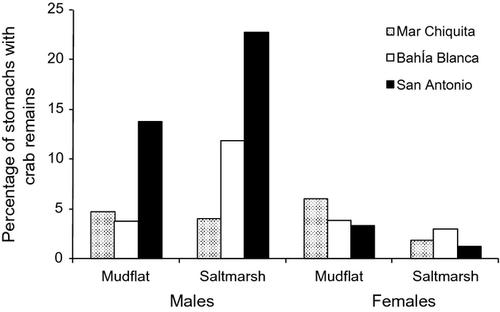
Feeding activity
Mar Chiquita. Since daily low and high tides may be of very different amplitude in this site, the intertidal was very irregularly covered during the sampled periods (Fig. 5). High tides reached the mudflat in the low intertidal in nine of the 16 flood tides, and the supratidal salt marsh was flooded only once during an extraordinary winter high tide. Some water remained in the mudflat area, at least in the small tidal creeks, between two successive flood tides. Since mudflat and salt marsh areas had different combinations of factors, they were analysed separately (using as factors diurnal phase, water covering and season). Spring was excluded from seasonal comparison in the mudflat because the combination of submersion and darkness was never registered. This season was later analysed separately for the effects of diurnal phase and water covering.
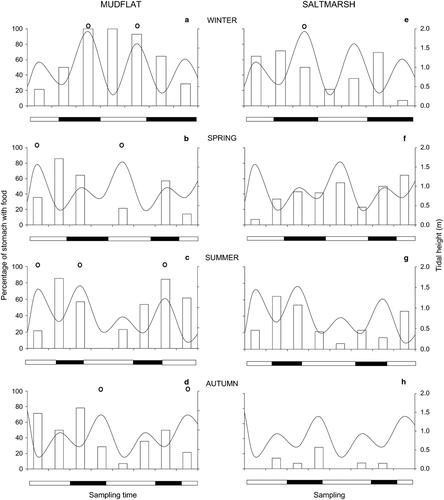
In the mudflat, the only factor that significantly affected the proportion of feeding crabs during summer, autumn and winter was the diurnal phase: more crabs had food in their stomachs after a dark period; neither season nor water covering had any effect, and no interactions existed among them (Table 2, Fig. 5a,c,d). In spring, neither water covering nor diurnal phase (analyzed separately) had an effect on feeding activity (Table 2, Fig. 5b). Interestingly, a special physical condition was present during the first 24 h of the spring sampling period: a drizzle kept the soil wet during low tide.
| Site | Habitat | Diurnal phase | Water covering | Season | Interactions | |
|---|---|---|---|---|---|---|
| MC | Mudflat | Summer, autumn, winter | χ2 = 17.5, P < 0.001, df = 1 | No effect, P > 0.05 | No effect, P > 0.05 | No, P > 0.05 |
| Spring | No effect, P > 0.05 | No effect, P > 0.05 | – | – | ||
| Saltmarsh | All seasons | χ2 = 5.81, P < 0.05, df = 1 | Not evaluated | χ2 = 29.47, P < 0.001, df = 3 | No, P > 0.05 | |
| BB | Mudflat | Spring, autumn, winter | Not considered | Not considered | Not considered |

|
| Summer | χ2 = 7.01, P < 0.01, df = 1 | χ2 = 26.15, P < 0.001, df = 1 | – | – | ||
| Saltmarsh | All seasons | Not considered | Not considered | Not considered | D-W-S, χ2 = 24.59, P < 0.001, df = 3 | |
| SA | Mudflat + saltmarsh | All seasons | χ2 = 19.09, P < 0.001 | Not considered | Not considered | H-W-S, χ2 = 9.02, P < 0.001, df = 2 |
- df, Degrees of freedom.
In the salt marsh, where tidal effect could not be evaluated (tide reached this zone only once), diurnal phase and season had an effect over feeding activity but their interaction was not significant (Table 2, Fig. 5e–h). More crabs presented food in their stomachs after dark hours, the highest activity was recorded in winter (Fig. 5e) and the lowest in autumn (Fig. 5h).
Bahía Blanca: tides covered the mudflat located in the upper part of the middle intertidal less regularly (Fig. 6); consequently, salt marsh and mudflat areas showed different combinations of factors and were also separately analyzed. In the mudflat, the combination of submersion and daylight was not recorded in summer, and this season was not considered for a seasonal comparison. Diurnal phase and water covering effects were separately analyzed later. In winter, spring and autumn, factors interacted in pairs (Table 2) presenting a complex combination of effects. Feeding activity of mudflat crabs was more intense in winter, followed by autumn, and spring (Fig. 6). In winter a high proportion of individuals presented food in their stomachs (Fig. 6a). In spring, proportions of feeding crabs >20% were only present when submersion and darkness coincided (Fig. 6b). In autumn, an extremely long period of water logging of the complete intertidal zone was produced during the entire sampling period: a strong south wind caused a delay in tide receding and a constant rain originated a continuous water saturation of soil even during low tide. Under those conditions no effect of any particular factor was evident in relation with the proportion of feeding crabs (Table 2, Fig. 6d). In summer, feeding activity in the mudflat was very low; it slightly increased only when water reached this area at dark (Fig. 6c); the surface of sediment was totally dry and compact after some hours of insolation (Table 2).
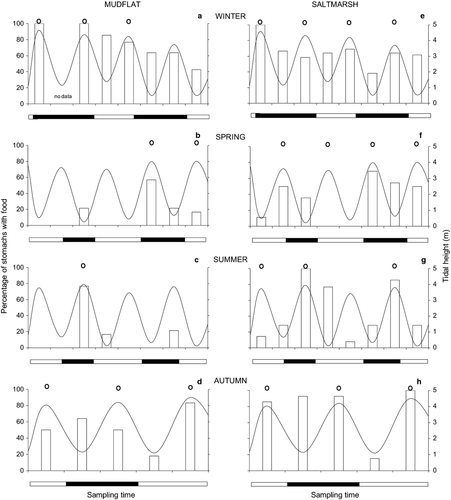
In the salt marsh, all the combinations of diurnal phase, water covering and season were present and analyzed together. The three factors interacted with each other (Table 2). In winter, the feeding activity was high during the whole sampling period (Fig. 6e). In spring and summer crabs fed mainly at dark and the proportion of filled stomachs increased after nocturnal submersion periods. Peaks in summer were higher than those in spring (Fig. 6f,g). Finally, in autumn, the proportion of feeding crabs was continuously high, probably in accordance with the long periods of submersion, as observed in the mudflat (Fig. 6h).
San Antonio: in this site tides are regular and all flood tides covered both mudflat and salt marsh habitats (Fig. 7). Water easily percolated the coarse sediment in the mudflat, which dried quickly after tidal receding, while the salt marsh remained wet for longer periods. Since all combinations of factors were recorded, all effects were analyzed together. Diurnal phase affected feeding activity, and a higher proportion of stomachs had food after dark periods. In addition, season, tide and habitat interacted with each other (Table 2). The interaction was explained by the following facts: (i) in winter, feeding activity was the lowest and almost the same in both habitats, being higher after submersion periods (Fig. 7a,e); (ii) in spring and summer, more crabs with food in their stomachs were collected in the salt marsh after a submersion period (Fig. 7f,g); (iii) during the same seasons, mudflat crabs also contained food in their stomachs after emersion periods, but when combined with darkness (Fig. 7b,c); in both seasons, many crabs could be observed eating on sediment out of burrows during nocturnal samples; (iv) in autumn, feeding activity was more intense in the mudflat after a submersion period (Fig. 7d) but it was uniformly high in the salt marsh (Fig. 7h).
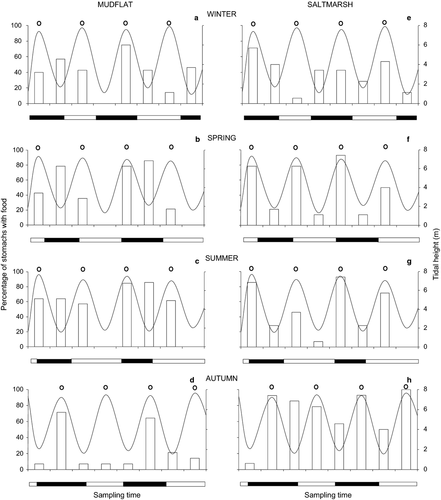
Ovigerous females were present in spring and summer in the three sites. Most of them had empty stomachs regardless the site, habitat, tide and light. The highest percentage of ovigerous females with some food in their stomach corresponded to SA, with 21%, whereas in the other two sites it only reached 10%.
Gut ecomorpholgy
The slope of the relationship log CW versus log SW did not differ among the three sites (F = 0.17, P > 0.05) and all data were pooled. The average standardized stomach size estimated was SW/CW = 0.442 ± 0.025. The percentage of herbivory for N. granulata, was 84%.
Discussion
What does Neohelice granulata eat?
Stomach contents found in Neohelice granulata during this study corroborated that this crab can be considered herbivorous and detritivorous, and can occasionally behave as carrion feeder or predator (Botto & Irigoyen 1979; D'Incao et al. 1990). In this study, we demonstrated that feeding activity and consumed items are plastic traits which change in accordance with different combinations of physical factors and food availability along the year at each site. In MC this crab behaves mainly as a grazer (or partially plant litter feeder) when it lives in the salt marsh, and as reported previously (Iribarne et al. 1997), as a deposit feeder when it inhabits the mudflat, but this pattern differs in other populations. Local differences in the productivity of Spartina species and the distribution of decayed material, sediment quality, and algae availability may explain the variations in feeding patterns observed in BB and SA.
A pattern of food ingestion as observed in MC occurred in BB in spring and summer, while in autumn and winter S. alterniflora was clearly incorporated as food by mudflat crabs. In MC and BB a peak of production of Spartina green biomass takes place in summer while minimum values appear in autumn-winter (González-Trilla 2010). However, while in MC the decayed material is consumed or exported to other parts of the ecosystem, in BB it typically accumulates in higher sections of the intertidal: in this site the salt marsh is located in the low intertidal and tidal currents of low energy move vegetal remains to higher zones (González-Trilla 2010). Then, the consumption of S. alterniflora by mudflat crabs in autumn and winter may be a consequence of the transport of decayed material in BB; this result also suggests that crabs prefer decayed leaves of S. alterniflora to sediment, when both are available.
In contrast and despite its lower content of organic matter (maximal 1.8 versus 4–5% reported in BB and MC; Bas et al. 2005; Luppi et al. 2013), crabs from SA salt marsh had higher sediment content in their stomachs (reaching 80% in winter). These crabs also incorporated a high proportion of algae to the diet, even when S. alterniflora was always available. Interestingly, nitrogen content is higher in algae than in Spartina (Enríquez et al. 1993). In winter, the ingestion of higher quantities of sediment by salt marsh crabs could make sense only if other available options (i.e. S. alterniflora) were of lower quality. The annual cycle of S. alterniflora has not been studied in SA but probably, winter is the season with the lowest productivity without growth of new stems, as it happens in the other studied populations (González-Trilla 2010); consequently, the quality of winter plants should be the poorest of the year. Algae, in addition, were not present in winter, while in the other seasons they were conspicuously carried by tides and deposited on the surface of mudflats and salt marshes. Accordingly, they were actively incorporated as food, if present. Some life history and reproductive traits of N. granulata from SA suggest that reproduction and growth are probably limited by the low content of energy of food (Bas et al. 2005; Ituarte et al. 2006): not only the organic matter of sediments was lower than in MC and BB but also, the protein content of Spartina leaves was 5.53% in Mar Chiquita and 4.71% in San Antonio (winter values; C. Bas, unpublished results). Furthermore, the notorious presence of crab remains in stomachs of males from SA salt marsh, being in many cases the only item recorded, suggests that the incorporation of new food items and the increase of cannibalism is a response to protein limitation. An inverse correlation between organic matter content of the sediment and the incidence of cannibalism was experimentally demonstrated in this species (Méndez Casariego et al. 2012). In addition, the difference between sexes in cannibalism could be related to the higher mobility of males (Luppi et al. 2013) and the larger size of their chelae.
The dual feeding mode observed in N. granulata (herbivorous and deposit feeder) is not common in animals. Semi-terrestrial crabs living in intertidal mangroves or salt marshes are mainly omnivorous deposit feeders (and plants are incorporated as detritus from sediment), or leaf litter feeders. Contrarily, species feeding on live plants are more terrestrial, i.e.: they live far from the intertidal (Dahdouh-Guebas et al. 1999; Linton & Greenaway 2007). The estuarine crab Armases cinereum has also an apparent dual feeding mode: it ingests live plants of Spartina when available but it behaves as deposit feeder, and partially a predator also, preferring a mixed diet over any other choice (Seiple & Salmon 1982; Buck et al. 2003). However, A. cinereum hardly ever had sediment particles in their stomachs (as occurred in N. granulata) because they selectively pick up detritus and small organisms from the substrate (Seiple & Salmon 1982).
As expected from the overall similarity in stomach contents, the relationship between body and stomach size did not differ among populations. Nevertheless, this relationship may be useful to compare gut ecomorphology between sedimentivorous and herbivorous crab species. The standardized stomach size (SW/CW) of brachyuran crabs correlates to the herbivory degree of the species: herbivorous crabs need to ingest high volumes of vegetable matter with low content of N whereas the food of carnivorous crabs is characterized by low volumes of a protein rich diet (Griffen & Mosblack 2011). According to Griffen & Mosblack model, (2011) the herbivory percentage predicted for the standardized stomach size of N. granulata should be 84%. However, high herbivory occurred only in crabs living in salt marshes, while most mudflat individuals had a lower proportion of plant food, and an important intake of sediment. Since it contains high quantities of inert material (about 95%; López & Levinton 1987), sediment is considered a very low quality food source. In consequence, larger stomach volumes would have been evolutionarily selected in detritivorous crabs as it happens in herbivorous ones, and the midgut morphology of both feeding modes is expected to be similar.
Where and when does Neohelice granulata eat?
Although N. granulata is the main grazer of Spartina species from SW Atlantic salt marshes, shifting to deposit feeding in some situations (Bortolus & Iribarne 1999; Bortolus et al. 2004; Alberti et al. 2007b), crabs were not frequently observed feeding in natural conditions. They are less active during low tides, when field studies are possible, and even a detailed research on the short distance movements around the refuges failed to detect feeding (Fathala et al. 2010); only indirect feeding evidences were obtained as marks left by chelae and small areas with the superficial layer of sediment removed around the burrows (C. Bas, personal observations). In the laboratory, crabs ingest sediment when placed in aquaria without water and with a bottom covered by mud saturated of water (Lancia et al. 2012); however, they do not manipulate sediment underwater (C. Bas, personal observations). Feeding on sediment in natural conditions should be restricted to periods after water receding while soil remains wet, moving inside burrows afterwards; in fact, a higher proportion of the individuals captured in mudflats after such periods had food in their stomachs. Furthermore, when low tides coincided with dark hours, low temperatures or rainy weather, the period of feeding on wet sediment increased since soil retained humidity for a longer time.
Crabs are even more difficult to observe in salt marshes than in mudflats, because they are hidden by plants; however, during rising tides, when water occasionally reach MC salt marsh, adult N. granulata (mainly males) have been seen moving with the water edge, climbing stems and eating leaves directly from plants of S. densiflora (Alberti et al. 2007a; C. Bas, personal observations). In the laboratory, males and females cut leaves of Spartina spp. with their chelae to eat them (Lancia et al. 2012). Besides, crabs eat leaves if they are offered as small fragments over a wet sediment layer (C. Bas, personal observations). In many sampled periods, the lack of association between water covering and feeding in salt marshes from different sites may be explained by the presence of two alternative modes of feeding on Spartina spp.: (i) to ingest living leaves or buds preferably during flooding periods when crabs may cut them directly from plants taking advantage of water flooding to climb, or (ii) to obtain decayed plant material from the soil out of the flooding period. In this way, different feeding patterns may respond to the combination of variable tidal covering and plant (fresh and decayed leaves) availability in different salt marshes and seasons.
From the results of this study, four trends were detected in the feeding behavior of N. granulata:
- More crabs from all sites and habitats fed nocturnally. Light is one of the main physical factors determining daily feeding cycles in intertidal crabs; the most common pattern is to obtain food largely at dark hours (e.g. Paul 1981; Aagaard et al. 1995), although it can vary among sites or habitats according to tidal amplitude in different sites (Ryer 1987; Cannicci et al. 1999). Feeding at dark may be advantageous because visual predators can be avoided and/or the physical stress caused by high temperature can be diminished. In MC and BB, for example, some birds that predate on N. granulata are visual predators active only during daylight hours (Luppi et al. 2013).
- Crabs preferred feeding during (or immediately after) high tides in sites where sediment and burrows dried rapidly during low tides (as in SA and BB mudflat), otherwise, they were independent of tides.
- Ovigerous females did not feed. These females hardly ever had food in their stomachs even when they were caught in the same area and at the same time as males and non-ovigerous females. Accordingly, they were very rarely found in movement traps where the other groups were captured (Luppi et al. 2013) suggesting that not only feeding but any movement outside burrows was restricted while females were brooding.
- Low quality food resources are associated with an increase in the intensity of cannibalism.
Summarizing, the feeding of adult N. granulata, indirectly studied here through the presence/absence and proportion of food items in crab stomachs is in first place an activity developed mainly within the habitat of each individual; at the same time, it seems to be flexible, adapting to different combinations of physical and biological factors. Ingested food items vary among sites, and a trend to omnivory (including algae and conspecifics) appears probably associated to low quality of main feeding resources and to the presence of alternative items.
Acknowledgements
This project was supported by the Universidad Nacional de Mar del Plata (EXA 440), ANPCyT (Argentina PICT 21757) granted to E.S. The English version was revised by Mrs. Anna Cosulich. A.M.C. and J. L. were supported by a Doctoral scholarship from CONICET (Argentina).



